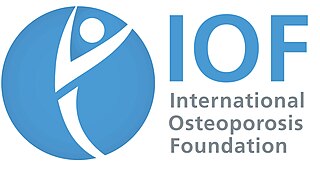
Osteoporosis is a systemic skeletal disorder characterized by low bone mass, micro-architectural deterioration of bone tissue leading to bone fragility, and consequent increase in fracture risk. It is the most common reason for a broken bone among the elderly. Bones that commonly break include the vertebrae in the spine, the bones of the forearm, and the hip. Until a broken bone occurs there are typically no symptoms. Bones may weaken to such a degree that a break may occur with minor stress or spontaneously. After the broken bone heals, the person may have chronic pain and a decreased ability to carry out normal activities.
The human skeleton is the internal framework of the human body. It is composed of around 270 bones at birth – this total decreases to around 206 bones by adulthood after some bones get fused together. The bone mass in the skeleton makes up about 14% of the total body weight and reaches maximum mass between the ages of 25 and 30. The human skeleton can be divided into the axial skeleton and the appendicular skeleton. The axial skeleton is formed by the vertebral column, the rib cage, the skull and other associated bones. The appendicular skeleton, which is attached to the axial skeleton, is formed by the shoulder girdle, the pelvic girdle and the bones of the upper and lower limbs.

Alendronic acid, sold under the brand name Fosamax among others, is a bisphosphonate medication used to treat osteoporosis and Paget's disease of bone. It is taken by mouth. Use is often recommended together with vitamin D, calcium supplementation, and lifestyle changes.

Sodium fluoride (NaF) is an inorganic compound with the formula NaF. It is a colorless or white solid that is readily soluble in water. It is used in trace amounts in the fluoridation of drinking water to prevent tooth decay, and in toothpastes and topical pharmaceuticals for the same purpose. In 2020, it was the 265th most commonly prescribed medication in the United States, with more than 1 million prescriptions. It is also used in metallurgy and in medical imaging.

Zoledronic acid, also known as zoledronate and sold under the brand name Zometa by Novartis among others, is a medication used to treat a number of bone diseases. These include osteoporosis, high blood calcium due to cancer, bone breakdown due to cancer, Paget's disease of bone and Duchenne muscular dystrophy (DMD). It is given by injection into a vein.

Fluoride or fluorine deficiency is a disorder which may cause increased dental caries and possibly osteoporosis, due to a lack of fluoride in diet. Common dietary sources of fluoride include tea, grape juice, wine, raisins, some seafood, coffee, and tap water that has been fluoridated. The extent to which the condition truly exists, and its relationship to fluoride poisoning has given rise to some controversy. Fluorine is not considered to be an essential nutrient, but the importance of fluorides for preventing tooth decay is well-recognized, despite the effect is predominantly topical. Prior to 1981, the effect of fluorides was thought to be largely systemic and preeruptive, requiring ingestion. Fluoride is considered essential in the development and maintenance of teeth by the American Dental Hygienists' Association. Fluoride incorporates into the teeth to form and harden teeth enamels. This makes the teeth more acid resistant, as well as more resistant to cavity forming bacteria. Caries-inhibiting effects of fluoride were first noticed 1902, when fluoride in high concentrations was found to stain teeth and prevent tooth decay.

Osteopenia, known as "low bone mass" or "low bone density", is a condition in which bone mineral density is low. Because their bones are weaker, people with osteopenia may have a higher risk of fractures, and some people may go on to develop osteoporosis. In 2010, 43 million older adults in the US had osteopenia. Unlike osteoporosis, osteopenia does not usually cause symptoms, and losing bone density in itself does not cause pain.

Bone density, or bone mineral density, is the amount of bone mineral in bone tissue. The concept is of mass of mineral per volume of bone, although clinically it is measured by proxy according to optical density per square centimetre of bone surface upon imaging. Bone density measurement is used in clinical medicine as an indirect indicator of osteoporosis and fracture risk. It is measured by a procedure called densitometry, often performed in the radiology or nuclear medicine departments of hospitals or clinics. The measurement is painless and non-invasive and involves low radiation exposure. Measurements are most commonly made over the lumbar spine and over the upper part of the hip. The forearm may be scanned if the hip and lumbar spine are not accessible.

Ibandronic acid is a bisphosphonate medication used in the prevention and treatment of osteoporosis and metastasis-associated skeletal fractures in people with cancer. It may also be used to treat hypercalcemia. It is typically formulated as its sodium salt ibandronate sodium.
Metabolic bone disease is an abnormality of bones caused by a broad spectrum of disorders. Most commonly these disorders are caused by deficiencies of minerals such as calcium, phosphorus, magnesium or vitamin D leading to dramatic clinical disorders that are commonly reversible once the underlying defect has been treated. These disorders are to be differentiated from a larger group of genetic bone disorders where there is a defect in a specific signaling system or cell type that causes the bone disorder. There may be overlap. For example, genetic or hereditary hypophosphatemia may cause the metabolic bone disorder osteomalacia. Although there is currently no treatment for the genetic condition, replacement of phosphate often corrects or improves the metabolic bone disorder. Metabolic bone disease in captive reptiles is also common, and is typically caused by calcium deficiency in a reptile's diet.

Denosumab is a human monoclonal antibody for the treatment of osteoporosis, treatment-induced bone loss, metastases to bone, and giant cell tumor of bone.

Femarelle is a dietary supplement that is a mixture of DT56a and flaxseed powder, that may act as a selective estrogen receptor modulator (SERM). In 2008 an application was submitted to the European Food Safety Authority to market Femarelle with a health claim, namely that it can reduce the risk for osteoporosis and other bone disorders; the EFSA found that "the food/constituent for which the claim is made, i.e. Femarelle, has not been sufficiently characterised" and that " a cause and effect relationship has not been established between the consumption of Femarelle and increased BMD, increased bone formation, or decreased risk of osteoporosis or other bone disorders in post-menopausal women."

Juvenile osteoporosis is osteoporosis in children and adolescents. Osteoporosis is rare in children and adolescents. When it occurs, it is usually secondary to some other condition, e.g. osteogenesis imperfecta, rickets, eating disorders or arthritis. In some cases, there is no known cause and it is called idiopathic juvenile osteoporosis. Idiopathic juvenile osteoporosis usually goes away spontaneously.

The Royal Osteoporosis Society (ROS), formerly the National Osteoporosis Society, established in 1986, is the only UK-wide charity dedicated to improving the prevention, diagnosis and treatment of osteoporosis. It is based in Camerton, Somerset, England.

Best Bones Forever! is a national bone health campaign that encourages girls ages 9–14 to adopt healthy habits for bone growth and osteoporosis prevention. The campaign was created by the U.S. Department of Health and Human Services’ Office on Women’s Health (OWH) in 2009. The campaign uses popular language, bright colors and images, and energetic messages to express a focus on fun and friendship. Best Bones Forever! aims to improve girls’ bone health behaviors, which include eating foods with calcium and vitamin D and participating in regular physical activity.

The International Osteoporosis Foundation (IOF), headquartered in Nyon, Switzerland, is a non-governmental organization (NGO) founded in 1998. It was formed from the merger of the European Foundation for Osteoporosis, founded in 1987, and the International Federation of Societies on Skeletal Diseases. The foundation functions as a global alliance of individuals and organizations concerned with the prevention, diagnosis and treatment of osteoporosis and musculoskeletal bone disease. The goal of the Foundation is to increase the early detection of osteoporosis and related musculoskeletal diseases, as well as to improve the treatment of these conditions through international collaboration among national healthcare systems and governments. The Foundation is the largest global NGO dedicated to osteoporosis and musculoskeletal diseases.

World Osteoporosis Day is observed annually on 20 October, and launches a year-long campaign dedicated to raising global awareness of the prevention, diagnosis and treatment of osteoporosis and metabolic bone disease. Organized by the International Osteoporosis Foundation (IOF), the World Osteoporosis Day campaign is accompanied by community events and local campaigns by national osteoporosis patient societies from around the world with activities in over 90 countries.
Romosozumab, sold under the brand name Evenity, is a medication used to treat osteoporosis. It has been found to decrease the risk of fractures of the spine.
Abaloparatide, sold under the brand name Tymlos among others, is a parathyroid hormone-related protein (PTHrP) analog medication used to treat osteoporosis. It is an anabolic agent.
Ambrish Mithal is an Indian endocrinologist and the Chairman and Head of Endocrinology and Diabetes at Max Healthcare- Pan-Max, Saket, New Delhi, where he started working in December 2019. He secured the master's degree (DM) from the All India Institute of Medical Sciences, New Delhi, and subsequently worked at Sanjay Gandhi Post Graduate Institute of Medical Sciences, Lucknow and, later, at Apollo Hospitals, New Delhi before joining Medanta the Medicity as Chairman, Division of Endocrinology and Diabetes where he worked from 2009 to 2019. Mithal was honoured by the Government of India in 2015 with Padma Bhushan, the third highest Indian civilian award, for his outstanding contribution to the field of medicine. In September 2020 Dr Mithal became the first Indian to be chosen for the Laureate Award for International Excellence in Endocrinology (2021) by the Endocrine Society (US).














